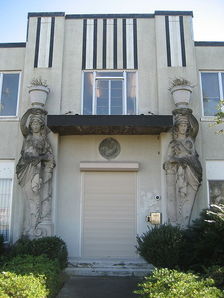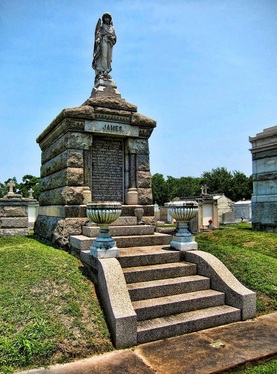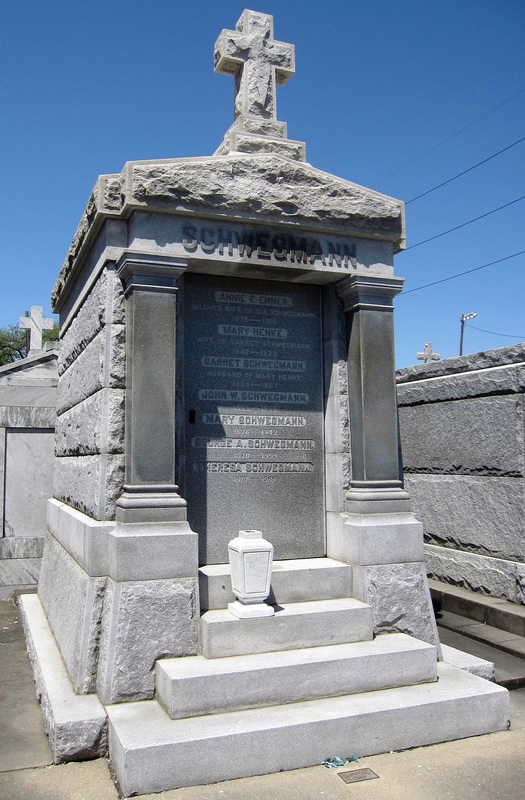|
On May 1, 1957, and only a few months shy of his 100th birthday, Albert Weiblen passed away in New Orleans. In his lifetime, Albert Weiblen was a revolutionary figure in New Orleans cemetery architecture. Under his carving hand, the craft of tomb building would expand from a hyper-local, individual cottage profession into a modern industry – spanning the eastern United States and powerfully altering the landscape of New Orleans cemeteries. A German Immigrant in New Orleans Albert Weiblen was born in 1857 in Metzingen, Wurttemberg, Germany. Sources suggest that he began his work as a sculptor in his homeland, apprenticing in the manner that was traditional for the time.[1] Weiblen immigrated to the United States in 1883 and soon afterward began work with local marble company Kursheedt and Bienvenu. Operational from 1867 to 1901, the company was co-owned by Edwin I. Kursheedt, a prolific stonecutter in his own right who, in addition to work in New Orleans’ Jewish cemeteries and other cemetery stonework, supplied the stone for the reconstruction of the Old State Capitol in Baton Rouge in the late 1880s.[2] At this time, New Orleans’ cemetery stonecutting industry was already changing. The florid, individualized Classical-revival tombs popular from the 1840s through the 1860s had given way not only to new styles inspired by Gothic and Italianate revival aesthetics, but also to economies of scale. The Yellow Fever epidemic of 1878 galvanized this trend. In this year, the construction of tombs shifted more to “cookie cutter” and slightly simplified styles, replicated by numerous carvers and builders.[3] Weiblen stepped into the cemetery craft scene in New Orleans at a time when this streamlining of tomb construction was in its infancy. New industrial technology, such as saws and machinery to cut granite and marble, new types of stronger hydraulic cements, and stonecutting technology powered by pneumatic chisels and even sandblasting, had been adopted elsewhere in the country, but were a long way off from making their debut in New Orleans cemeteries.[4] When these new tools and methods did arrive, though, it was often Weiblen who spearheaded their use. In 1887, Weiblen left Kursheedt & Bienvenu’s and started his own marble and granite company.[5] His first office and show room was located at 233 Baronne Street, a location he expanded by 1893.[6] Weiblen’s big break came in 1891 when his company won the contract to construct the memorial obelisk to New Orleans Superintendent of Police David Hennessy. Hennessy was murdered on October 15, 1890, an event which sparked riots in New Orleans and led to the lynching of eleven Italian-Americans. The contest had been open to many New Orleans monument men, including Charles A. Orleans, the city’s prominent monument builder at the time.[7] The monument was described by national trade periodical Stone magazine as “one of the handsomest monuments in New Orleans”:
From this location, Weiblen had a workshop complete with powerful equipment to cut, shape, polish, and engrave marble and granite slabs. At the turn of the century, Weiblen’s equipment was not only state of the art (the largest in the South), but was also one-of-a-kind in New Orleans, where technologies were relatively slow to catch on.[10] A skilled marketer and self-advertiser, Weiblen described this equipment in detail in his advertisements, spending nearly half of one circa 1900 advertising booklet explaining its advantages over “the old-time and very laborious manner of cutting by hand.”[11] That Weiblen frequently looked outside of New Orleans for materials and technologies made him, in general, a man of his time. By 1900, the monument industry in the United States was galvanizing as a national trade. Periodicals and trade magazines illustrating the newest and best quarries, saws, cutting methods, and others flourished. Even in New Orleans, Charles Orleans and others had begun to reach outward to peers in the east, newly accessible by infrastructure. Yet Weiblen certainly had a flare for this type of resourcefulness. In 1905, he recruited stonecutters directly from Barre, Vermont, for his shop in New Orleans.[12] The stonecutting shop on City Park Avenue holds in itself a history as visible as any of Weiblen’s tombs. Expanded into the company’s primary sales office in 1907, by the 1920s Weiblen came into possession of five marble sculptures that were once part of the old New Orleans Cotton Exchange. Two of these sculptures, caryatids from the Exchange entranceway, were incorporated into the showroom entrance. The other three, representing Commerce, Industry, and Agriculture, were scrapped for their marble, fell victim to vandalism, or were used as road fill, respectively. The caryatids, however, remain in the Weiblen building, which now houses the Orleans Parish Communication District.[13] The Quarry Man In 1911, Albert Weiblen and his son George leased an interest in a quarry at Stone Mountain, Georgia, from the Venable Brothers company. This was one of a number of savvy moves by the elder Weiblen that helped him cut down his supply chain. By the 1930s, Weiblen would lease another quarry in Elberton, Georgia. His sons, George, Frederick, and John, would all live at the Georgia quarries.[14] In the 1920s, the Weiblens – specifically George and Frederick (who died in 1927) – would begin a long journey of involvement in the carving of the Confederate monument at Stone Mountain, which would not be completed until 1970, the year of George’s death. At these quarries, Weiblen further expanded his infrastructural advantage. By 1936, Weiblen had constructed a full-service carving shop on-site at his Elberton quarry – complete with one of the largest air compressors in the country.[15] Paired with the rail spur he had also built, this permitted Weiblen Marble and Granite to streamline its orders directly from the source. In 1940, Weiblen moved all of his manufacturing operations to Elberton. From this point on, tombs, monuments, and other orders would be ordered from catalogs by customers in New Orleans, manufactured in Elberton, and sent direct by rail to Louisiana, ready for assembly.[16] This advantage also allowed Weiblen to flood the New Orleans market with the products of his quarries, directly transported by rail from their source. Between 1900 and 1940, Weiblen's activities bolstered a stylistic and material shift in New Orleans cemetery architecture. Granite was much more accessible than in the past, and led to new uses as facing and coping material. Georgia marble overtook other sources for new closure tablets, copings, tomb claddings, and other elements. Ever on the marketing edge, Weiblen Marble and Granite even coined a new name for a specific type of Georgia marble, distinguished by sweeping gray and white color patterns: Georgia “Creole” marble (now called “solar gray”). Other burgeoning New Orleans suppliers took up the source, leading Creole marble to be found in large sections of cemeteries like Greenwood, Masonic, and Metairie. Weiblen also attached his name to the granite his company supplied, which is known even today in some circles as “Weiblen gray.” A Cemetery Family Weiblen’s success was passed on to his surviving sons, George and John. George Weiblen operated the Stone Mountain and Elberton interests until his death in 1970. John Weiblen, alternately, assumed his father’s mantle as president of Weiblen Marble and Granite, after Albert Weiblen’s retirement. It was at this time, between 1948 and 1951, that the family company assumed controlling interest in Metairie Cemetery Association. While the purchase of arguably the most prestigious cemetery in New Orleans would have been a grand accomplishment, it also coincided with a larger trend among New Orleans stonecutters in the 1940s.[17] With the monument industry widening to a national scale, and paired with other factors surrounding cemetery management and use, the traditional model of the New Orleans stonecutter that once suited in the nineteenth century was no longer adequate after World War II. This trend was present across all New Orleans cemeteries. In Protestant Girod Street Cemetery, the position of sexton (caretaker), historically held by a stonecutter, was eliminated. This was true also of City-owned cemeteries like Lafayette, Carrollton, Holt, and Valence, in which the position of sexton was eliminated and the management of cemeteries delegated to the City Department of Property Management. The role of the stonecutter, then, was no longer supported by specific cemeteries.[18] Across New Orleans, it became more economically feasible for stonecutters and monument men to shift paradigms from being caretakers of cemeteries to owning the cemeteries outright. Sextons of the Lafayette Cemeteries for three generations, the Alfortish family moved to Gretna and opened Westlawn Cemetery. Victor Huber, monument dealer and caretaker of St. John Cemetery, assumed controlling interest of that burial ground and opened Hope Mausoleum. In 1951, the Stewart family purchased property adjoining Metairie Cemetery and opened Lake Lawn Park and Mausoleum.[19] In this sense, Weiblen’s shift from producer of Metairie’s monuments to owner of Metairie’s business was a natural one. John Weiblen preceded his father in death in 1956, leaving his widow, Norma Merritt Weiblen, to manage Metairie Cemetery, which she did so until the property was purchased by Stewart Enterprises, Inc., in 1968.[20] Passing the Torch According to son George, on the morning of May 1, 1957, Albert Weiblen “said he wanted to lie down before breakfast… took one deep breath and he was gone.” At the age of 99 years, Albert Weiblen died, leaving a legacy of innumerable monuments, buildings, statutes, and sculptures behind him. Still working on the Stone Mountain sculpture in the 1960s, George Weiblen noted that he wanted to find a way to carve his father’s name into the stone, “I don’t know how I will work his name in, but there is a way.” Long after Weiblen’s death, the cemeteries of New Orleans bear the mark of his work at nearly every turn. One estimate suggests that nearly half the tombs and monuments in Metairie Cemetery were constructed by Weiblen’s company.[21] In fact, a street off of Canal Boulevard near Greenwood Cemetery is even named after the great monument man. Albert Weiblen was buried in Metairie Cemetery, under a red granite monument. Weiblen's monuments, tombs, buildings, and other projects are innumerable. Weiblen even designed and built the Cuban capitol at Havana. The collection of images below is only a small example of the work of his lifetime.
[1] Leonard V. Huber, Peggy McDowell, and Mary Louise Christovich, New Orleans Architecture, Vol. III: The Cemeteries (Gretna: Pelican Publishing, 2004), 55, 62; “Time Marches On, but Weiblen Memorials Remain to Remind,” Times-Picayune, January 25, 1937, 170.
[2] Emily Ford, The Stonecutters and Tomb Builders of Lafayette Cemetery No. 1, New Orleans, Louisiana (MS Thesis, Clemson University, 2013), http://tigerprints.clemson.edu/all_theses/1613/, 96. [3] Ibid. 121-132. [4] Ibid. 164-181. [5] “Time Marches On, but Weiblen Memorials Remain to Remind,” Times-Picayune, January 25, 1937, 170; Soards’ New Orleans Directories, 1885-1910, these directories discourage the notion that Weiblen actually purchased Kursheedt & Bienvenu, which continued until 1901. [6] “Albert Weiblen Marble and Granite Co., Inc.” Times-Picayune, January 25, 1937, 170. [7] Huber et. al., New Orleans Architecture, Vol. III: The Cemeteries, 61-62. [8] “The Hennessy Monument,” Stone – An Illustrated Magazine, Vol. V (June-November 1892), 142. [9] “Ship Brings Cargo of Italian Marble,” Times-Picayune, July 27, 1914, 8; “A Big New Orleans Plant,” Rock Products, Vol. VII, No. 7 (January 1908), 23. [10] “A Prominent Southern Establishment,” The Reporter, Vol. 32 (August 1899), 7. [11] c. 1900 advertising pamphlet, Weiblen Marble and Granite Company, from Tulane University Southeastern Architectural Archive, Collection 39. [12] “Wanted,” Barre Daily Times, July 26-30, 1905, 7. [13] “More about the caryatids,” Times-Picayune, November 17, 1987, 12. [14] “Fred. E. Weiblen Succumbs Here: Was Executor of Granite Work on Confederate Monument,” Times-Picayune, April 12, 1927, 3. [15] 1936 advertising brochure, Tulane University Southeastern Architectural Archive, Collection 36. [16] 1946 advertising brochure, Tulane University Southeastern Architectural Archive, Collection 36; “Marble Works as New Policy,” Times-Picayune, October 2, 1940, 11. [17] “Stone Company Executive Dies,” Times-Picayune, March 23, 1956, 5; Huber, et. al., 59. [18] “Girod Cemetery Vandals Hunted,” Times-Picayune, June 7, 1952, 3; “A Strong Fund,” Times-Picayune, August 23, 1942, 10; Ford, 116. [19] “Lake Lawn Park Plans Revealed: One of Largest Mausoleums in US Promised,” Times-Picatune, March 8, 1950, 42. [20] “He brings city of dead to life,” Times-Picayune, April 14, 1985, B-8. [21] Huber, et. al., 55.
2 Comments
Joyce Morgan
11/15/2021 12:06:18 pm
Thank you so much for this lovely article, which I have preserved for my family. My husband Fred, who is named for his grandfather Frederick Weiblen, is the only great grandson of Albert Weiblen. Albert's great granddaughter Jeannie is also living. Their mother, Emily Weiblen Morgan was the only grandchild of Albert, the daughter of Frederick who died when she was 4. Emily is now 99 (like her grandfather Albert was when he died)/. She is in the very last days of her life, and not able to enjoy this article. You did a wonderful job on it. I love the photo of the Barronne shop. Had not seen that one. Albert and his family lived in the same building as the shop. His wife Susannah died at 33 of silicosis. She was mother of Albert's 3 sons.
Reply
9/30/2022 05:31:30 pm
Very interesting article! We have a Weiblen monument in Monroe, LA which marks the grave of a fallen soldier of the Spanish American War. I noticed his mark on the marker and went down the rabbit hole from there!
Reply
Leave a Reply. |
About the Author:Emily Ford owns and operates Oak and Laurel Cemetery Preservation, LLC. Archives
November 2019
Categories
All
|
- About
-
Restoration
- Services
-
Portfolio
>
- Turning Angel Statue, Natchez, MS
- Ledger Monument, Baton Rouge, LA
- Pyramid Statuary, New Orleans, LA
- Bronze and Granite Monument, Carville, LA
- Box Tomb, New Orleans, LA
- Vernacular Concrete Monument, Pensacola, FL
- 1830s Family Tomb, Covington, LA
- 1850s Family Tomb, New Orleans, LA
- 1880s Family Tomb, New Orleans, LA
- Headstone and Monument Restorations, Pensacola, FL
- Society Tomb, New Orleans, LA
- Education
- Blog
- Contact
|
Oak and Laurel Cemetery Preservation, LLC is a preservation contractor in New Orleans, Louisiana, specializing in historic cemeteries, stone conservation, educational workshops and lectures. Oak and Laurel serves the region of the Southeastern US.
|
QUICK LINKS |
CONNECT |
Proudly powered by Weebly


































